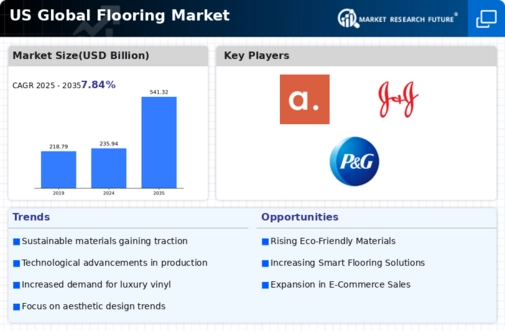Growth in Commercial Construction
The commercial construction sector is a vital driver for the flooring market in the US. With a projected growth rate of around 4% annually, the demand for flooring solutions in commercial spaces such as offices, retail, and hospitality is on the rise. This growth is attributed to an increase in new construction projects and renovations of existing facilities. As businesses seek to create appealing environments for customers and employees, the flooring market is likely to see a corresponding increase in demand for durable and aesthetically pleasing flooring options. The commercial sector's investment in quality flooring solutions is expected to significantly contribute to the overall market expansion.
Increased Focus on Health and Wellness
The growing emphasis on health and wellness is influencing consumer choices in the flooring market. Many consumers are now prioritizing flooring materials that promote better indoor air quality and are free from harmful chemicals. This trend is particularly evident in the residential sector, where homeowners are opting for natural and sustainable flooring options. The market for eco-friendly flooring is projected to grow by approximately 10% annually, reflecting a shift towards healthier living environments. As awareness of the impact of flooring materials on health increases, the flooring market is expected to adapt by offering more products that align with these consumer values.
Rising Demand for Residential Renovations
The flooring market in the US is currently experiencing a surge in demand driven by an increase in residential renovations. Homeowners are increasingly investing in upgrading their living spaces, which often includes new flooring solutions. According to recent data, the home improvement market is projected to reach approximately $450 billion by 2026, with flooring being a significant component of this growth. This trend is likely influenced by a desire for enhanced aesthetics and functionality in homes. As consumers prioritize comfort and style, the flooring market is expected to benefit from this renovation boom, leading to a diverse range of products being offered to meet varying consumer preferences.
Evolving Consumer Preferences for Customization
Consumer preferences are evolving towards greater customization in the flooring market. Homeowners and businesses alike are seeking unique flooring solutions that reflect their personal style and brand identity. This trend is driving manufacturers to offer a wider array of colors, textures, and materials. The customization market is expected to expand, with estimates indicating a growth rate of around 12% over the next few years. As consumers become more discerning in their choices, the flooring market is likely to respond by providing tailored solutions that cater to individual tastes and requirements.
Technological Advancements in Flooring Solutions
Technological advancements are reshaping the flooring market in the US, introducing innovative products that enhance performance and sustainability. The integration of smart technologies, such as moisture sensors and temperature control systems, is becoming more prevalent in flooring solutions. These advancements not only improve the functionality of flooring but also appeal to environmentally conscious consumers. The market for smart flooring is anticipated to grow, with estimates suggesting a potential increase of 15% in the next five years. As manufacturers continue to innovate, the flooring market is likely to witness a shift towards more technologically advanced and sustainable options.














Leave a Comment